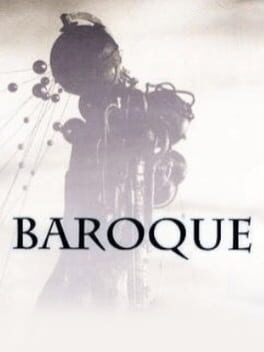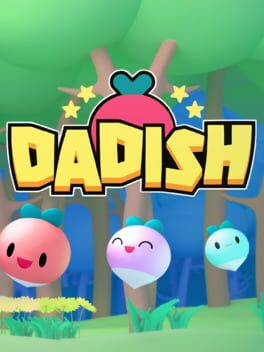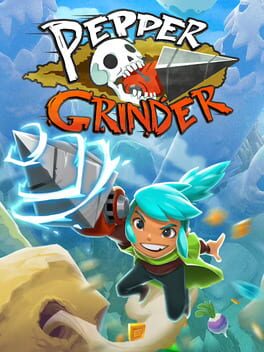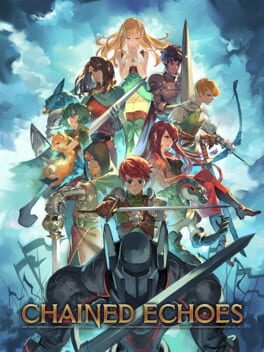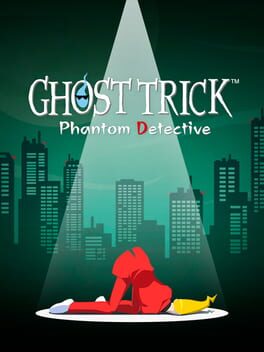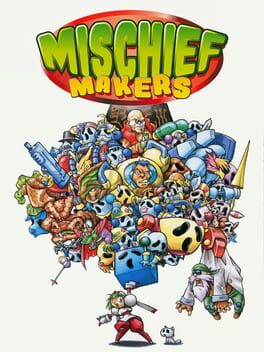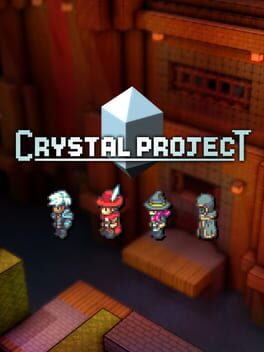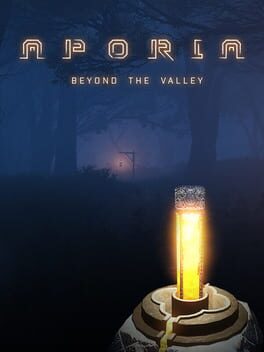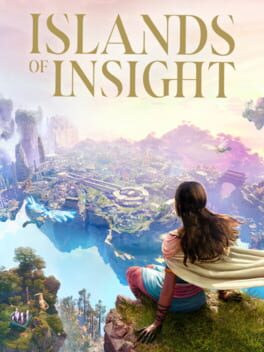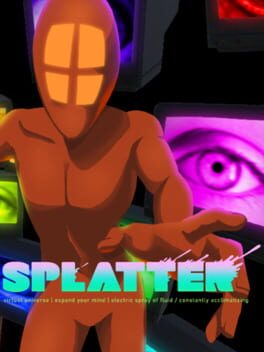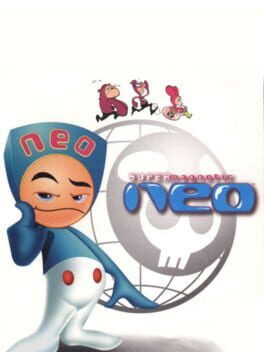Silverhand
BACKER
783 Reviews liked by Silverhand
Baroque
1998
You ever play something so ahead of its time that you could trick someone into believing that it just came out yesterday?
Seriously, what the fuck? 1998? I know Dungeon Hack existed for half a decade before this, and Wizardry a decade before that, but this feels advanced. Like, this might just be me speaking from ignorance, having not played the fifteen years of first-person dungeon crawlers building up to this, but there's something about the entire design philosophy of this that seems modern. Roguelikes weren't new at the time — you know, what with Rogue existing — nor were real-time blobbers, but combining them into one entity that encourages multiple playthroughs to peel back an obfuscated story is something that I last saw in The Binding of Isaac and in precisely zero games before that.
This game is impossibly cool. Let this be the most Hot Topic thing I ever say, but there's something about these hellish industrial land-and-soundscapes that make me feel a sense of belonging. Having a world that's in such an obvious, complete state of disrepair that you can't do much besides band together is a welcome reprieve from our world where everything is awful but the collective populace pretends as though it's fine. Comfort in discomfort; the end-times as impetus to make what's left over better. Of course, that isn't going to stop opportunists like Coffin Man from picking your corpse for loot, but it's not like he's gonna kill you for it, either.
It's a difficult title to discuss, and that's mostly due to how reliant it is on being experienced. This is probably a bit of a nothing statement, given that everything is designed to be experienced by someone, but the actual act of attempting to engage with the game feels more like "the gameplay" than its actual mechanics. Attempting to define this by putting it in neat boxes of clearing rooms and slashing up monsters and leveling up does a disservice to the whole. You cannot break this down into its parts without losing the magic that binds them all together.
I mentioned in my Last Call BBS review that I have a hard time with puzzle-solving because I can't really figure out how to learn how to solve them. With that said, though, brushing through Baroque's cryptic design came naturally to me. It's a game not just of learning, but of risk-management. You learn that Bones are items that can be thrown or consumed to deal enemies and apply buffs, respectively, but what do you do when you find an unidentified Bone on the floor? Do you gnaw on it and risk hurting yourself, or do you toss it at the enemy and risk giving them total invulnerability? When you find a new weapon, do you equip it right away to identify it, or do you avoid doing so because it might have an "adhesive" that makes it impossible to take off? These are basic tenets of Rogue games, but are they really different to puzzles in any meaningful way? You're meant to use your reasoning to figure out what the best course of action should be, and then following that path. Is that distinct from puzzle-solving?
I suppose what makes Baroque work for me is that there's never a binary right or wrong answer. There are good answers, and bad answers, but never right or wrong. Gnawing on a damaging bone will hurt you, but only for 10/20 HP (you start with 99). Stepping on a status pad might afflict you with Lust or Darkness, but only for a minute or two. The game can be harsh, but never unfair. You can never make a single mistake that'll cost you the run; you have to make several mistakes in sequence before you're in danger. I like not being judged completely on a scale of "you did it/you didn't do it". You can succeed here in a lot of different ways, but it's just that some ways are more efficient than others.
Immaculate vibes. It's a wonder that this got a translation nearly 25 years after it released.
Seriously, what the fuck? 1998? I know Dungeon Hack existed for half a decade before this, and Wizardry a decade before that, but this feels advanced. Like, this might just be me speaking from ignorance, having not played the fifteen years of first-person dungeon crawlers building up to this, but there's something about the entire design philosophy of this that seems modern. Roguelikes weren't new at the time — you know, what with Rogue existing — nor were real-time blobbers, but combining them into one entity that encourages multiple playthroughs to peel back an obfuscated story is something that I last saw in The Binding of Isaac and in precisely zero games before that.
This game is impossibly cool. Let this be the most Hot Topic thing I ever say, but there's something about these hellish industrial land-and-soundscapes that make me feel a sense of belonging. Having a world that's in such an obvious, complete state of disrepair that you can't do much besides band together is a welcome reprieve from our world where everything is awful but the collective populace pretends as though it's fine. Comfort in discomfort; the end-times as impetus to make what's left over better. Of course, that isn't going to stop opportunists like Coffin Man from picking your corpse for loot, but it's not like he's gonna kill you for it, either.
It's a difficult title to discuss, and that's mostly due to how reliant it is on being experienced. This is probably a bit of a nothing statement, given that everything is designed to be experienced by someone, but the actual act of attempting to engage with the game feels more like "the gameplay" than its actual mechanics. Attempting to define this by putting it in neat boxes of clearing rooms and slashing up monsters and leveling up does a disservice to the whole. You cannot break this down into its parts without losing the magic that binds them all together.
I mentioned in my Last Call BBS review that I have a hard time with puzzle-solving because I can't really figure out how to learn how to solve them. With that said, though, brushing through Baroque's cryptic design came naturally to me. It's a game not just of learning, but of risk-management. You learn that Bones are items that can be thrown or consumed to deal enemies and apply buffs, respectively, but what do you do when you find an unidentified Bone on the floor? Do you gnaw on it and risk hurting yourself, or do you toss it at the enemy and risk giving them total invulnerability? When you find a new weapon, do you equip it right away to identify it, or do you avoid doing so because it might have an "adhesive" that makes it impossible to take off? These are basic tenets of Rogue games, but are they really different to puzzles in any meaningful way? You're meant to use your reasoning to figure out what the best course of action should be, and then following that path. Is that distinct from puzzle-solving?
I suppose what makes Baroque work for me is that there's never a binary right or wrong answer. There are good answers, and bad answers, but never right or wrong. Gnawing on a damaging bone will hurt you, but only for 10/20 HP (you start with 99). Stepping on a status pad might afflict you with Lust or Darkness, but only for a minute or two. The game can be harsh, but never unfair. You can never make a single mistake that'll cost you the run; you have to make several mistakes in sequence before you're in danger. I like not being judged completely on a scale of "you did it/you didn't do it". You can succeed here in a lot of different ways, but it's just that some ways are more efficient than others.
Immaculate vibes. It's a wonder that this got a translation nearly 25 years after it released.
Resident Evil 4
2011
Replayed RE4, this time using the "real" version with controller rather than mouse and keyboard. The argument I had heard was that re4 wasn't properly balanced for mouselook, which makes the broken headshot + kick combo for crowd control a lot easier. And after playing it, yeah that's definitely the case, especially at first.This WAS my second playthrough though, and after getting used to the stiffness (and the added clunkiness of playing on a handheld switch with default joycons) I found it to not be that much harder than the PC version.
Its a credit to RE4 that even when I was playing horrendously, getting my ass handed to me by that initial village siege and even running out of ammo a few times in the beginning, I was still having a blast. Its also probably indicative of RE4's dynamic difficulty system, that I struggled the most with the early game, so I'm guessing it took pity on me. I admit I haven't played the other RE games other than a bit of Revelations 2, mainly because they seem more horror-y and less action-y.
I played through RE4 during a weeklong trip to london where I was away from my PC. Unfortunately that meant I had to interrupt my playthrough of Killer 7 (which does share some surface similarities to RE4, both part of the capcom 5, both made by mikami, both combine puzzles and shooting at slow enemies, etc) which due to my ADHD almost always murders my motivation/interest for a game. It proved to be the case here as well, I'll have to complete the second half of that game at some other point in the future.
I also attempted pro-mode for re4 but quite frankly, it's beyond my abilities. I made it to stage 3-2 or so and I just couldn't play well enough to not be stomped on by the onslaught of cultists. Supporting my theory that RE4's dynamic difficulty was going easy on me, as pro mode simply locks you to the highest difficulty the whole way through. Its a shame, because for the first few levels, it actually increased my enjoyment of RE4, by forcing me to play "better", exploiting every advantage and learning new strats to overcome the insane odds.
I still think the island is lame, as long as the castle goes on for, I think its the high point for the game. Its also insane to me that the Del Lago bossfight is the first bossfight in the game. First of all, because it sucks, the worst bossfight in the game imo, but also because you'd think the gimmick boss fight using different-ish mechanics to the core gameplay would be put in around the middle or something, to shake things up, but no. Its especially weird cause almost inmediately you have El Gigante which is both a better bossfight and would make a much better first boss.
I still had to laugh during the cutscene before Del Lago, when the castillian peasant says "andale". To those who don't know about spanish dialects, thats like making a game set in rural australia and seeing a random bogan say in his best Larry the Cable guy impression : git er dun! Or something along those lines. Its not even just that the NPCs sound mexican or whatever, cause some of them sound like spanish isn't their first language, others sound plausibly from mainland spain but their dialogue was seemingly machine translated from english? And okay, they kinda get the benefit of the doubt cause the location within spain is never specified, but their pronunciation of "imbecil" indicates they use "seseo" which would mean they are either in southern spain or the canary islands, neither of which sound likely. The real answer is "who gives a shit? They grabbed whomever around the office who knew some spanish and put em in the recording booth" and It doesn't actually bother me, hell, Ive heard the remake replaces the VO with more accurate, professional voices and that sounds lame as hell.
So yeah, RE4 is still good, and now I can say I beat it "properly".
Its a credit to RE4 that even when I was playing horrendously, getting my ass handed to me by that initial village siege and even running out of ammo a few times in the beginning, I was still having a blast. Its also probably indicative of RE4's dynamic difficulty system, that I struggled the most with the early game, so I'm guessing it took pity on me. I admit I haven't played the other RE games other than a bit of Revelations 2, mainly because they seem more horror-y and less action-y.
I played through RE4 during a weeklong trip to london where I was away from my PC. Unfortunately that meant I had to interrupt my playthrough of Killer 7 (which does share some surface similarities to RE4, both part of the capcom 5, both made by mikami, both combine puzzles and shooting at slow enemies, etc) which due to my ADHD almost always murders my motivation/interest for a game. It proved to be the case here as well, I'll have to complete the second half of that game at some other point in the future.
I also attempted pro-mode for re4 but quite frankly, it's beyond my abilities. I made it to stage 3-2 or so and I just couldn't play well enough to not be stomped on by the onslaught of cultists. Supporting my theory that RE4's dynamic difficulty was going easy on me, as pro mode simply locks you to the highest difficulty the whole way through. Its a shame, because for the first few levels, it actually increased my enjoyment of RE4, by forcing me to play "better", exploiting every advantage and learning new strats to overcome the insane odds.
I still think the island is lame, as long as the castle goes on for, I think its the high point for the game. Its also insane to me that the Del Lago bossfight is the first bossfight in the game. First of all, because it sucks, the worst bossfight in the game imo, but also because you'd think the gimmick boss fight using different-ish mechanics to the core gameplay would be put in around the middle or something, to shake things up, but no. Its especially weird cause almost inmediately you have El Gigante which is both a better bossfight and would make a much better first boss.
I still had to laugh during the cutscene before Del Lago, when the castillian peasant says "andale". To those who don't know about spanish dialects, thats like making a game set in rural australia and seeing a random bogan say in his best Larry the Cable guy impression : git er dun! Or something along those lines. Its not even just that the NPCs sound mexican or whatever, cause some of them sound like spanish isn't their first language, others sound plausibly from mainland spain but their dialogue was seemingly machine translated from english? And okay, they kinda get the benefit of the doubt cause the location within spain is never specified, but their pronunciation of "imbecil" indicates they use "seseo" which would mean they are either in southern spain or the canary islands, neither of which sound likely. The real answer is "who gives a shit? They grabbed whomever around the office who knew some spanish and put em in the recording booth" and It doesn't actually bother me, hell, Ive heard the remake replaces the VO with more accurate, professional voices and that sounds lame as hell.
So yeah, RE4 is still good, and now I can say I beat it "properly".
Dadish
2020
Pepper Grinder
2024
Ah. That’s more like it.
As the one person I know who likes Donkey Kong Country, Drill Dozer, and that one burrowing escape sequence from Ori and the Will of the Wisps, I knew Pepper Grinder was going to be right up my alley. What impressed me though, was just how precisely the game melded its influences into something that felt simultaneously fresh yet familiar. The level design is classic obstacle escalation (introduce a concept, scale it up, throw in a twist, and then run the player through a final exam into their victory lap) with DKC inspired secrets with skull coin collectibles for unlocking secret levels. Many of the usual formula beats are present as well to force execution tests, from the usual moving parts in the forms of cannons, rope swings, and grappling points, to constantly present sources of danger like the freezing ocean or the temporary dirt patches created from cooling lava. What sets Pepper Grinder apart however, is that the terrain itself is the main obstacle. It feels like such a natural pairing to seamlessly mesh environmental navigation with the course’s very foundation, and the best moments of the game lean into funneling the player through various layers of shifting and isolated terrain while tearing through all that may stand in their way.
That said, I think to really understand the nuances of Pepper Grinder, one has to readily commit to its time attack mode. I could have been sold on the game-feel alone as an amalgam of Donkey Kong Country’s momentum physics and Drill Dozer’s force feedback, but playing under circumstances that force you to squeeze every possible second out of the timer gives the player a better appreciation of its movement mechanics. Pepper is not very fast on foot, nor can she naturally jump very far. Therefore, you’d think that most speed comes from tunneling through terrain, but it’s not quite that either. Rather, the player has to maintain momentum through the interplay of drilling and jumping by exiting terrain via the drill run (boosting right as you’re about to leave a patch of dirt), which commits the player to the projected arc leaving the terrain but with the reward of significantly more speed. The result is some of the weightiest and most satisfying movement I have ever experienced in any platformer. I was constantly figuring out new ways to save seconds by timing by boosts both within terrain and right before exiting terrain (since you can’t just spam boost and using it too early can lock you out from getting the necessary boost jump out of terrain), skipping certain obstacles entirely with well-placed drill runs, and figuring out how to manage my health to bypass unfavorable cycles and damage boost past mines and thorns. Some of those gold time attack medals were tight ordeals, but I absolutely savored every moment of the grind.
Bosses as a whole are a significant improvement from the usual quality of those in Donkey Kong Country. You’re not safe just waiting above ground, and burrowing to dodge attacks forces you to at least dash-dance underground since drilling means you can’t stay in one place. As a result, the player is constantly on the move, and you’re incentivized to do so anyways given that most of the bosses require multiple hits to defeat and aren’t the usual “invincible until they’re done attacking” crop from DKC. The biggest complaint I can levy here is that boss hit/hurtboxes can feel imprecise; I’ve heard that many players have had difficulty figuring out how to correctly drill into the beetle boss’s underbelly, and while I had no issues there, I did die a few times from the skeleton king’s heel hitbox where there was no visible attack in its vicinity. Still, I much prefer these boss fights over many of its peers, and figuring out when and how to best aim drill runs from the ground to speedrun bosses was just as much of a pleasure as speedrunning the courses themselves.
There are a few questionable design choices that could be touched upon here. Firstly, there’s a shop system present where you can purchase optional stickers from a gacha machine as well as temporary health boosts. The former is mostly forgivable given that they don’t impact the gameplay otherwise and can be cleared in about three minutes of purchasing and opening capsules. That said, I feel as if the latter could be removed entirely given that I never felt pressured to purchase insurance for courses and bosses, especially because I was often taking hits anyways to skip past obstacles and because you’re not going to regain the extra health capacity in-level once it’s gone. Secondly, bosses in time-attack mode force you to watch their opening unskippable cutscenes before getting to the action, and this gets extremely irritating when you’re constantly restarting fights to get better times. Finally, Pepper Grinder has a few gimmick areas in the forms of a couple of robot platforming segments, two snowmobile sections where you just hold forward on the control stick, and a couple of run-and-gun levels with little drilling involved. I can look past most of these given that they don’t take up much time and that I enjoyed all the minecart levels from DKC as is, though I do wish that they spaced the gimmicks apart a bit more given that levels 4-3 and 4-4 both have significant run and gun segments sending each course off.
If I did have any lasting complaints, it would be that I just want more of this game. Most players will finish adventure mode in under four hours. That said, even despite a lack of polish here and there, I absolutely adore Pepper Grinder. At this time of writing, I’ve 100%ed the game and even gone back to a few time trials after snagging all the gold medals just to further polish my records. It’s often difficult for me to pin down what makes a game feel good to play, but in this case, I just know. Pepper Grinder feels like an adrenaline rush made just for me, and though its execution barriers and short length will likely make this a tough sell for many, it is undoubtably some of the most fun I have had with a game this year. If you’re curious or enjoy anything that I’ve discussed in this write-up, please give the demo a shot. They don’t make 2D platformers like this anymore, and Pepper Grinder’s existence leaves me wondering why when they absolutely killed it on their first try.
As the one person I know who likes Donkey Kong Country, Drill Dozer, and that one burrowing escape sequence from Ori and the Will of the Wisps, I knew Pepper Grinder was going to be right up my alley. What impressed me though, was just how precisely the game melded its influences into something that felt simultaneously fresh yet familiar. The level design is classic obstacle escalation (introduce a concept, scale it up, throw in a twist, and then run the player through a final exam into their victory lap) with DKC inspired secrets with skull coin collectibles for unlocking secret levels. Many of the usual formula beats are present as well to force execution tests, from the usual moving parts in the forms of cannons, rope swings, and grappling points, to constantly present sources of danger like the freezing ocean or the temporary dirt patches created from cooling lava. What sets Pepper Grinder apart however, is that the terrain itself is the main obstacle. It feels like such a natural pairing to seamlessly mesh environmental navigation with the course’s very foundation, and the best moments of the game lean into funneling the player through various layers of shifting and isolated terrain while tearing through all that may stand in their way.
That said, I think to really understand the nuances of Pepper Grinder, one has to readily commit to its time attack mode. I could have been sold on the game-feel alone as an amalgam of Donkey Kong Country’s momentum physics and Drill Dozer’s force feedback, but playing under circumstances that force you to squeeze every possible second out of the timer gives the player a better appreciation of its movement mechanics. Pepper is not very fast on foot, nor can she naturally jump very far. Therefore, you’d think that most speed comes from tunneling through terrain, but it’s not quite that either. Rather, the player has to maintain momentum through the interplay of drilling and jumping by exiting terrain via the drill run (boosting right as you’re about to leave a patch of dirt), which commits the player to the projected arc leaving the terrain but with the reward of significantly more speed. The result is some of the weightiest and most satisfying movement I have ever experienced in any platformer. I was constantly figuring out new ways to save seconds by timing by boosts both within terrain and right before exiting terrain (since you can’t just spam boost and using it too early can lock you out from getting the necessary boost jump out of terrain), skipping certain obstacles entirely with well-placed drill runs, and figuring out how to manage my health to bypass unfavorable cycles and damage boost past mines and thorns. Some of those gold time attack medals were tight ordeals, but I absolutely savored every moment of the grind.
Bosses as a whole are a significant improvement from the usual quality of those in Donkey Kong Country. You’re not safe just waiting above ground, and burrowing to dodge attacks forces you to at least dash-dance underground since drilling means you can’t stay in one place. As a result, the player is constantly on the move, and you’re incentivized to do so anyways given that most of the bosses require multiple hits to defeat and aren’t the usual “invincible until they’re done attacking” crop from DKC. The biggest complaint I can levy here is that boss hit/hurtboxes can feel imprecise; I’ve heard that many players have had difficulty figuring out how to correctly drill into the beetle boss’s underbelly, and while I had no issues there, I did die a few times from the skeleton king’s heel hitbox where there was no visible attack in its vicinity. Still, I much prefer these boss fights over many of its peers, and figuring out when and how to best aim drill runs from the ground to speedrun bosses was just as much of a pleasure as speedrunning the courses themselves.
There are a few questionable design choices that could be touched upon here. Firstly, there’s a shop system present where you can purchase optional stickers from a gacha machine as well as temporary health boosts. The former is mostly forgivable given that they don’t impact the gameplay otherwise and can be cleared in about three minutes of purchasing and opening capsules. That said, I feel as if the latter could be removed entirely given that I never felt pressured to purchase insurance for courses and bosses, especially because I was often taking hits anyways to skip past obstacles and because you’re not going to regain the extra health capacity in-level once it’s gone. Secondly, bosses in time-attack mode force you to watch their opening unskippable cutscenes before getting to the action, and this gets extremely irritating when you’re constantly restarting fights to get better times. Finally, Pepper Grinder has a few gimmick areas in the forms of a couple of robot platforming segments, two snowmobile sections where you just hold forward on the control stick, and a couple of run-and-gun levels with little drilling involved. I can look past most of these given that they don’t take up much time and that I enjoyed all the minecart levels from DKC as is, though I do wish that they spaced the gimmicks apart a bit more given that levels 4-3 and 4-4 both have significant run and gun segments sending each course off.
If I did have any lasting complaints, it would be that I just want more of this game. Most players will finish adventure mode in under four hours. That said, even despite a lack of polish here and there, I absolutely adore Pepper Grinder. At this time of writing, I’ve 100%ed the game and even gone back to a few time trials after snagging all the gold medals just to further polish my records. It’s often difficult for me to pin down what makes a game feel good to play, but in this case, I just know. Pepper Grinder feels like an adrenaline rush made just for me, and though its execution barriers and short length will likely make this a tough sell for many, it is undoubtably some of the most fun I have had with a game this year. If you’re curious or enjoy anything that I’ve discussed in this write-up, please give the demo a shot. They don’t make 2D platformers like this anymore, and Pepper Grinder’s existence leaves me wondering why when they absolutely killed it on their first try.
Baroque
1998
I felt the need to revisit this because in my review I suggested that the core gameplay loop could get tired very quickly, which seemed antithetical to a game that clearly wants you to take your time with it. I still stand by that evaluation; however, after submitting my review, I then began doing full tower runs every day for like a week. It was painfully easy - aside from a couple of deaths early on while I was still getting used to the game, I have completed every single run of the dungeon I started. Once you're acquainted with the mechanics, you can pretty much stumble through Baroque half-awake, and that's exactly what I did. The gameplay is simple but requires just enough thought that I can use 15% of my brain and use the other 85% for wizard stuff. And yet, for some godsforsaken reason, I couldn't stop. I felt a strange kind of comfort in walking through the Nerve Tower's halls, having become so well-acquainted with them, and each time I saw the credits roll I took the opportunity to chill out to the music and reflect. I should probably see a psychiatrist, but overall I just think Baroque hits all of the right notes for me as a person. I feel comfortable in saying that it's one of my new favorite games, but it's not the kind I'd readily recommend to all of my friends. I am unabashedly in love with the narrative and the world, though, and I'm glad that I had the opportunity to play it.
Ridge Racer V
2000
Not a bad game by any means but a step back from Type 4 in almost every aspect. Handling reverts to how it felt in the original Ridge Racer and we once again lose track variety in favour of all circuits being variations of the same base layout but it's the presentation that suffers the most and feels jarring when played out of time.
Chained Echoes
2022
Chained Echoes has so much to like while also managing to feel unpolished in many other ways. It's genuinely impressive how much one person has created here, with a strong art direction, a solid story, and some great music as well. The battle system is the area that I take the most issue with. The ovedrive / overheat system is cool in theory, but ends up resulting in more micromanagement than necessary, often getting in the way of strategies by requiring random moves to reduce the heat bar. The Sky Armor battles feel even worse, given there are fewer ways to manage the heat bar. On top of this, too many bosses have the ability to act multiple times per turn, creating some scenarios that feel truly unfair. Despite these quirks, I did enjoy Chained Echoes a good bit, but it wasn't as enjoyable as it could have been.
Mischief Makers
1997
Crystal Project
2022
If I made a game, and I say this with zero game dev experience, it'd probably be something like this. Not necessarily my "dream game", but this has so, SO much stuff I'd put into a game.
A class system with that allows for a lot of creative synergy? Check. A huge world that has tons of hidden bosses and secrets? Yep. Challenging turn based gameplay where even the non-boss encounter requires you to give it your all? Got that. A story that... actually the story really isn't there. If a normal RPG is about 45% story and 55% gameplay, Crystal Project is closer to... 2% story, 98% gameplay. For context, my final game time on Steam was just under 40 hours, and there were several optional areas and superbosses that I haven't seen yet, plus a chocobo-like breeding game.
If you want to know if you'll like this game, then you'll have to love turned-based battles and exploration.
Let me stress this point, exploration is a huge component. Nearly as important as the the battle system. It starts fairly simple, but then you start to get mounts that allow you to reach areas previously unreachable. Still sounds standard... until you realize the game's world is all interconnected. It's an entire open world game made by one dev. Its kinda crazy. Not one area takes place in some separate dimension, such as entering a world map in other RPGs. You can fall off a giant cliff and plummet all the way into the ocean. And if you can swim by that point in the game, you can seamlessly go underwater and find treasure and dangerous foes in the ocean's depths.
Speaking of foes, this game is fairly tough all things consider. While it is possible in some parts of the game, most of the time grinding levels isn't an immediate "I win" tactic for the more difficult encounters. It certainly helps, but if you do a lot of side content then you'll reach max level quickly, and will still be struggling if you made your party poorly. The game does have your back in many ways. Your stat-increases are dependent on the class your character was when they level up, but you can rollback and redistribute them if you aren't satisfy with your build. The game is very transparent about its mechanics, like the exact calculations it uses when calculating damage, what party member an enemy will attack next turn; even the exact damage values, crit chance & crit damage, and accuracy percentage for every attack you do is clear as day.
I played on my new Steam Deck and it was the one game that didn't drain my Deck in 30 minutes, which was nice to say the least. Have had some notable graphical hiccups, namely with the world taking a bit too long to load after fast traveling or moving at high speeds. I had no issues with this personally, but a lot of music and game assets are used from many royalty-free dev sites. I felt it was done well enough that I didn't notice during my playtime, plus it does rightfully credit where they came from so it by no means tries to hide it. Only big issue I had was that I would've like a little nudge towards some of the more interesting discoveries in this game. This game world is massive and it can be exciting but also very overwhelming. I had to look at a guide (which there are so few of) more then once to get at least a vague direction for points of interest, some of which are very easy to miss.
If world building and story is what you love about RPGs, then this is ain't for you sadly. Me though, this was just sweet dopamine in my brain the whole way through.
Did I mention this game also has an in-depth randomizer? Like random bosses, enemies, class locations, items, and more? This'll keep me busy that's for sure.
A class system with that allows for a lot of creative synergy? Check. A huge world that has tons of hidden bosses and secrets? Yep. Challenging turn based gameplay where even the non-boss encounter requires you to give it your all? Got that. A story that... actually the story really isn't there. If a normal RPG is about 45% story and 55% gameplay, Crystal Project is closer to... 2% story, 98% gameplay. For context, my final game time on Steam was just under 40 hours, and there were several optional areas and superbosses that I haven't seen yet, plus a chocobo-like breeding game.
If you want to know if you'll like this game, then you'll have to love turned-based battles and exploration.
Let me stress this point, exploration is a huge component. Nearly as important as the the battle system. It starts fairly simple, but then you start to get mounts that allow you to reach areas previously unreachable. Still sounds standard... until you realize the game's world is all interconnected. It's an entire open world game made by one dev. Its kinda crazy. Not one area takes place in some separate dimension, such as entering a world map in other RPGs. You can fall off a giant cliff and plummet all the way into the ocean. And if you can swim by that point in the game, you can seamlessly go underwater and find treasure and dangerous foes in the ocean's depths.
Speaking of foes, this game is fairly tough all things consider. While it is possible in some parts of the game, most of the time grinding levels isn't an immediate "I win" tactic for the more difficult encounters. It certainly helps, but if you do a lot of side content then you'll reach max level quickly, and will still be struggling if you made your party poorly. The game does have your back in many ways. Your stat-increases are dependent on the class your character was when they level up, but you can rollback and redistribute them if you aren't satisfy with your build. The game is very transparent about its mechanics, like the exact calculations it uses when calculating damage, what party member an enemy will attack next turn; even the exact damage values, crit chance & crit damage, and accuracy percentage for every attack you do is clear as day.
I played on my new Steam Deck and it was the one game that didn't drain my Deck in 30 minutes, which was nice to say the least. Have had some notable graphical hiccups, namely with the world taking a bit too long to load after fast traveling or moving at high speeds. I had no issues with this personally, but a lot of music and game assets are used from many royalty-free dev sites. I felt it was done well enough that I didn't notice during my playtime, plus it does rightfully credit where they came from so it by no means tries to hide it. Only big issue I had was that I would've like a little nudge towards some of the more interesting discoveries in this game. This game world is massive and it can be exciting but also very overwhelming. I had to look at a guide (which there are so few of) more then once to get at least a vague direction for points of interest, some of which are very easy to miss.
If world building and story is what you love about RPGs, then this is ain't for you sadly. Me though, this was just sweet dopamine in my brain the whole way through.
Did I mention this game also has an in-depth randomizer? Like random bosses, enemies, class locations, items, and more? This'll keep me busy that's for sure.
Aporia: Beyond the Valley understands three fundamental things about Myst: not everybody picked Myst up for the puzzles(t); to a subset of players, the mystery of why they were on Myst Island was more fascinating than any answer the game could ever hope to give them; Myst was kind of scary. If you could never escape the first island but wanted to keep exploring, Aporia was made for you. That isn't to say that there isn't an emphasis on puzzle solving here—what game inspired by Myst would be replete without that? But the puzzles here are pretty simplistic and, in my experience, only require brainpower due to occasionally lacking feedback. The real draw of Aporia is its atmosphere. While being clearly made on a budget ensures that not every corner of this world looks as pleasant as others (the starting area's artificial-looking water and dreary dark corners belie how breathtaking the second area's lake is), everything from the lighting to the environment design compels you to explore and ask questions the entire time. This focus on atmosphere extends to its slow pace, lack of explicitly stated direction, and lack of spoken dialog. That lack of direction can be a double-edged sword because, while it draws you closer to its mystery, it ensures that any significant breaks taken from playing this is bound to confuse. I find the lack of dialog to be a very fascinating touch, however, as it ensures that this is a story that could only be told and understood through the lens of it being a video game. I don't want to get too pretentious sounding with my praise, but I love it when I see it.
Overall, from what I've played of Aporia, I recommend it. But I can totally see why this is so niche and has flown under so many radars. It's a bit of a bummer that the majority of the people who own this have never played it (only 28% of the people who have played it have found a map, and I'm not bullshitting those numbers). If you're one of the many who bought this with a 75% off coupon at some point or bought it for a dollar through Humble Bundle like I did back then, I recommend checking it out if you're looking for something more deliberate and laconic.
t= wording has been corrected to be more inclusive.
Overall, from what I've played of Aporia, I recommend it. But I can totally see why this is so niche and has flown under so many radars. It's a bit of a bummer that the majority of the people who own this have never played it (only 28% of the people who have played it have found a map, and I'm not bullshitting those numbers). If you're one of the many who bought this with a 75% off coupon at some point or bought it for a dollar through Humble Bundle like I did back then, I recommend checking it out if you're looking for something more deliberate and laconic.
t= wording has been corrected to be more inclusive.
Islands of Insight
2024
Islands of Insight is a game filled with a self boasted 10,000+ puzzles. These range from logic grids where you must deduce where black/white tiles go based on rules, gliding through ring puzzles, many perspective puzzles, memory grids, grids in which you must replicate a "song", glass mazes, a couple types of hidden objects, and other stuff. Overall there are officially 24 different types of puzzles, but the logic grids themselves have plenty of different rules to make them a game on their own. Most of them I find fun to do, while others I just ignored because I don't wanna expend the effort. There are also plenty of easier puzzles to do if you get pissed once puzzles get too hard, which I do! Morphic Phractic puzzles are fucking stupid and I never really tried to understand them. They are like kaleidoscopes, but you gotta twist and turn your mouse until you get the exact right visuals it shows you; just could not figure out how to operate it.
How does this game contain these puzzles? Well, with a pretty good sized open world. It's not like this world hold's 10,000 puzzles at once, no, they are on rotations and "reset" at set times. There are 5 biomes where you can travel around solving whatever puzzles you see, this sensation to me is like Saints Row 4 where you just get lost collecting the orbs. Its a fun flow state of going from puzzle to puzzle. To help you travel along, you get a Double Jump (!!!) and a glide that can last a long time. These movement options are so dope. Making a game fun to move around in is awesome!
These larger open segments aren't the only mode though, there are actual structured segments where the dev's put permanent puzzles to solve. These are the "story" that you go through essentially. The story to this game is like nothing, and I didn't read like any of the lore I picked up. Just kind of vague nonsense I think, but maybe it is good, idk!
This game is also a MMO, kind of(?). So this game is an online game (sadly for any offline wanters) and it is a very strange for it. Since it is online, you can see other plays wandering around doing stuff, which is pretty cute I guess, but there is no meaningful way for them to interact with puzzles/help each other. You can party with friends, but there isn't really an in game way for helping. Like you can't co-op puzzles together, but you can just like talk with someone in VC about the puzzle or whatever. You can also ping stuff like hidden objects or whatever to help people.
In combination with this game being online, there are a huge range of cosmetics to unlock through Mastery (experience). Every puzzle type has its own Mastery levels, and whenever you level up a puzzle, and when you level up 10 times like that, your total Mastery level goes up 1. This works like a "Battle Pass" in the way that every level gives you a reward (ranging from currency, lore fragments, and cosmetics). Whenever you do a puzzle you get XP and currency; and some cosmetics can only be bought by currency.
Currency can also be used on the skill tree. The skill tree mostly consists of perks that give you more mastery/currency the better you do puzzles (ex: do grid puzzles with 0 mistakes, or solve certain puzzles fast). The skill tree also gives you QOL stuff like a paint fill bucket for the logic grids, or a super jump to get to high places. You can do this super jump 3 times, then it has a 5 minute cooldown which is just asinine to me.
There are also mysteries you unlock that tell you vague descriptors of a place, and what you must do there. Like it will describe an area with a logic grid, then tell you new rules to use instead of it usually is. They are cool extra shit for people who wanna solve shit detective style.
Overall, I like the large variety of puzzles in this game, and I honestly felt like I did get better at the puzzles (up to a point). If you like puzzles, casually or more so, I really think you should check this out.
How does this game contain these puzzles? Well, with a pretty good sized open world. It's not like this world hold's 10,000 puzzles at once, no, they are on rotations and "reset" at set times. There are 5 biomes where you can travel around solving whatever puzzles you see, this sensation to me is like Saints Row 4 where you just get lost collecting the orbs. Its a fun flow state of going from puzzle to puzzle. To help you travel along, you get a Double Jump (!!!) and a glide that can last a long time. These movement options are so dope. Making a game fun to move around in is awesome!
These larger open segments aren't the only mode though, there are actual structured segments where the dev's put permanent puzzles to solve. These are the "story" that you go through essentially. The story to this game is like nothing, and I didn't read like any of the lore I picked up. Just kind of vague nonsense I think, but maybe it is good, idk!
This game is also a MMO, kind of(?). So this game is an online game (sadly for any offline wanters) and it is a very strange for it. Since it is online, you can see other plays wandering around doing stuff, which is pretty cute I guess, but there is no meaningful way for them to interact with puzzles/help each other. You can party with friends, but there isn't really an in game way for helping. Like you can't co-op puzzles together, but you can just like talk with someone in VC about the puzzle or whatever. You can also ping stuff like hidden objects or whatever to help people.
In combination with this game being online, there are a huge range of cosmetics to unlock through Mastery (experience). Every puzzle type has its own Mastery levels, and whenever you level up a puzzle, and when you level up 10 times like that, your total Mastery level goes up 1. This works like a "Battle Pass" in the way that every level gives you a reward (ranging from currency, lore fragments, and cosmetics). Whenever you do a puzzle you get XP and currency; and some cosmetics can only be bought by currency.
Currency can also be used on the skill tree. The skill tree mostly consists of perks that give you more mastery/currency the better you do puzzles (ex: do grid puzzles with 0 mistakes, or solve certain puzzles fast). The skill tree also gives you QOL stuff like a paint fill bucket for the logic grids, or a super jump to get to high places. You can do this super jump 3 times, then it has a 5 minute cooldown which is just asinine to me.
There are also mysteries you unlock that tell you vague descriptors of a place, and what you must do there. Like it will describe an area with a logic grid, then tell you new rules to use instead of it usually is. They are cool extra shit for people who wanna solve shit detective style.
Overall, I like the large variety of puzzles in this game, and I honestly felt like I did get better at the puzzles (up to a point). If you like puzzles, casually or more so, I really think you should check this out.
Disney's Goof Troop
1993
obviously with mikami at the top of the masthead on this one it's very tempting to extract the seeds of resident evil and his later titles out of this one. hmmm... limited inventory, you say? narrow corridors with dangerous enemies that you have to expend limited ammo against or lure away through subtle AI manipulation?? all these environments that loop back on themselves... you can really see the sketches of the spencer mansion here...
but really, it's heavily streamlined zelda in the same way quackshot is heavily streamlined metroid. the structure is effectively five dungeons in the classic single-screen room format strung along with some cute cutscenes of goofy and max trying to rescue pete and pj from a group of pirates. there's no resource management; exiting and reentering a room resets the majority of its state, which includes various throwable objects used to attack enemies. occasionally a puzzle will affect something in the next room over, but by and large every room here is a self-contained puzzle, ranging from "clear all the enemies" to push-block puzzles to a couple things in between. they're pretty solid too: the push-block puzzles often require using certain blocks to line up others, keeping the mapping of routes from becoming rote, and since clearing a room requires paying attention to where throwables are located and how to access them, some cool ideas arise from determining an order of attack and manipulating enemies to assist you with killing others. AI manipulation puzzles are a thing as well, ensconced into the game's toolkit with a bell item that draws aggro and thus controls enemy movement. the concepts stay remarkably fresh throughout, although given that the game is only a couple hours long, it would be tedious if this wasn't the case. a couple favorites of mine would be ones where you trick enemies into walking into oncoming fire from cannons and a particular one where you line up four enemies in a corridor to kill them with a single sliding block.
beyond throwing items and kicking blocks, goofy can hold two items at any given time to assist in particular puzzles. other than the bell one mentioned earlier, the hookshot serves the most "interesting" purpose of the bunch, as it can both stun enemies and create tightropes. not exactly exhilarating, but its latter purpose consumes the item, making searching for new hookshots an additional intrigue that drives exploration. beyond these the applications lack substance; the candle widens the sight radius in infrequent dark rooms, keys are just keys, and shovels can be used to farm life-up items in some rare locales with movable dirt. in this way the restriction of holding only two items at once becomes less demanding, since the latter set are so situational that holding onto them longer than a room or two will always be a waste. by the late game item-reliant puzzles give way to ones that leverage the game's inherent mechanics, so it seems like the designers figured this out as well.
but really, it's heavily streamlined zelda in the same way quackshot is heavily streamlined metroid. the structure is effectively five dungeons in the classic single-screen room format strung along with some cute cutscenes of goofy and max trying to rescue pete and pj from a group of pirates. there's no resource management; exiting and reentering a room resets the majority of its state, which includes various throwable objects used to attack enemies. occasionally a puzzle will affect something in the next room over, but by and large every room here is a self-contained puzzle, ranging from "clear all the enemies" to push-block puzzles to a couple things in between. they're pretty solid too: the push-block puzzles often require using certain blocks to line up others, keeping the mapping of routes from becoming rote, and since clearing a room requires paying attention to where throwables are located and how to access them, some cool ideas arise from determining an order of attack and manipulating enemies to assist you with killing others. AI manipulation puzzles are a thing as well, ensconced into the game's toolkit with a bell item that draws aggro and thus controls enemy movement. the concepts stay remarkably fresh throughout, although given that the game is only a couple hours long, it would be tedious if this wasn't the case. a couple favorites of mine would be ones where you trick enemies into walking into oncoming fire from cannons and a particular one where you line up four enemies in a corridor to kill them with a single sliding block.
beyond throwing items and kicking blocks, goofy can hold two items at any given time to assist in particular puzzles. other than the bell one mentioned earlier, the hookshot serves the most "interesting" purpose of the bunch, as it can both stun enemies and create tightropes. not exactly exhilarating, but its latter purpose consumes the item, making searching for new hookshots an additional intrigue that drives exploration. beyond these the applications lack substance; the candle widens the sight radius in infrequent dark rooms, keys are just keys, and shovels can be used to farm life-up items in some rare locales with movable dirt. in this way the restriction of holding only two items at once becomes less demanding, since the latter set are so situational that holding onto them longer than a room or two will always be a waste. by the late game item-reliant puzzles give way to ones that leverage the game's inherent mechanics, so it seems like the designers figured this out as well.
Splatter
2022
Really interesting arena shooter, maybe a bit too ingrained into internet culture at points, with humour becoming way too many layers deep into irony to really be anything at all. But for the most part the writing here is really solid and some great combat to go along side it, even if there are some issues with frame rate and floatiness of both the pc and enemies.
Super Magnetic Neo
2000
crash-like with a twist: you can emanate a magnetic field around yourself for either polarity, north or south. magnetized items (with color-coded polarity for your convenience) will respond appropriately; if you use the opposite polarity, you'll be pulled towards the object, and if you use the same polarity, you'll be pushed away. in practice the implementation is rather ticky-tacky, with the actual interactable set being limited to jump pads you trigger with the same polarity and swings/ziplines you trigger with the opposite polarity. not necessarily a compelling hook on its own, and indeed, the game is a bit of a hard sell. it uses crash's one-hit kill system without a corresponding amount of shield items, its life system is somewhat stingy, and the game outwardly tends towards trial and error, with many magnetic interactable sections coming down to memorizing polarity sequences.
overcome these punitive aspects, however, and you'll find a rare platformer that virtually never repeats an idea. across sixteen levels the game flips the script at virtually every checkpoint, putting fresh spins on ideas from earlier in the level or introducing completely bespoke setpieces and puzzles. in the last level alone, the game introduces stomping hydraulic presses with temporary platforms in between, a curved rainbow slope leading down to a bottomless pit, piston platforms raising and lowering from an electric pit on a cycle (first on an alternating cycle, secondly all synchronized, with parallel bounce pads to suspend yourself between when the platforms lower), alternating lasers on either side of a gap with bounce pads that fling you to the other side, a series of different cycling platforms over lava with enemies you can throw to destroy doors, and a race to exit a safe before platforms crumble in sequence, with spotlights swirling around that trigger lasers on each line of blocks. that's one five minute level! it's erratic and creative in the best ways, switching tempo on the fly between fast-paced, timed platforming and slower throwable-enemy puzzle sections. there's a klonoa-esque flair to its puzzles, but where klonoa would iterate upon individual mechanics and structures to create conceptually driven levels, magnetic neo just tosses ideas off and moves on. a frantic way to approach design.
that alone makes it fascinating, but in a trial-and-error environment, the actual responses to these challenges would be rigid. however, the magnetism component has the subtle addition of proper inertia regarding when one activates and deactivates their magnetic field. this applies both to timing interaction with swings and ziplines to fly off at certain directions and speeds as well as adjusting the angle off of launch pads. sections involving these interactables become more fluid in how they're approached, with minor skips cropping up in various sections when using the physics to one's advantage. the levels are specifically designed around these mechanics, with many sections having multiple different ways to traverse them explicitly laid out by the developers. the simplest configuration of this is having one path dedicated to magnetic elements and the other as a straight platforming sequence; it seems in some instances they punish players who refuse to learn the speedier yet more opaque magnetism sections with long-winded cycle platforming. however, some sections go even beyond this, having the two paths intertwine in such a way that one could seamlessly transition between them depending on how they conduct their movement. considering its corridor-based level design, the open-ended nature of these setpieces bolsters the explorability of their mechanics and reduces the tedium of repetition.
the environments match the design techniques in their commitment to never staying the same, as demonstrated in level 2-3. the level starts at the base of a pyramid, scaling it and soaring through it as the level progresses. when finally it reaches the stratosphere, the background transforms into an oasis above a bed of clouds, capping off the scene with the stark blue sky above. the game keeps this fervor for change throughout. while simple, it matches the strengths of the dreamcast nicely: flat lighting, clean and seamless characters, and bright colors.
overcome these punitive aspects, however, and you'll find a rare platformer that virtually never repeats an idea. across sixteen levels the game flips the script at virtually every checkpoint, putting fresh spins on ideas from earlier in the level or introducing completely bespoke setpieces and puzzles. in the last level alone, the game introduces stomping hydraulic presses with temporary platforms in between, a curved rainbow slope leading down to a bottomless pit, piston platforms raising and lowering from an electric pit on a cycle (first on an alternating cycle, secondly all synchronized, with parallel bounce pads to suspend yourself between when the platforms lower), alternating lasers on either side of a gap with bounce pads that fling you to the other side, a series of different cycling platforms over lava with enemies you can throw to destroy doors, and a race to exit a safe before platforms crumble in sequence, with spotlights swirling around that trigger lasers on each line of blocks. that's one five minute level! it's erratic and creative in the best ways, switching tempo on the fly between fast-paced, timed platforming and slower throwable-enemy puzzle sections. there's a klonoa-esque flair to its puzzles, but where klonoa would iterate upon individual mechanics and structures to create conceptually driven levels, magnetic neo just tosses ideas off and moves on. a frantic way to approach design.
that alone makes it fascinating, but in a trial-and-error environment, the actual responses to these challenges would be rigid. however, the magnetism component has the subtle addition of proper inertia regarding when one activates and deactivates their magnetic field. this applies both to timing interaction with swings and ziplines to fly off at certain directions and speeds as well as adjusting the angle off of launch pads. sections involving these interactables become more fluid in how they're approached, with minor skips cropping up in various sections when using the physics to one's advantage. the levels are specifically designed around these mechanics, with many sections having multiple different ways to traverse them explicitly laid out by the developers. the simplest configuration of this is having one path dedicated to magnetic elements and the other as a straight platforming sequence; it seems in some instances they punish players who refuse to learn the speedier yet more opaque magnetism sections with long-winded cycle platforming. however, some sections go even beyond this, having the two paths intertwine in such a way that one could seamlessly transition between them depending on how they conduct their movement. considering its corridor-based level design, the open-ended nature of these setpieces bolsters the explorability of their mechanics and reduces the tedium of repetition.
the environments match the design techniques in their commitment to never staying the same, as demonstrated in level 2-3. the level starts at the base of a pyramid, scaling it and soaring through it as the level progresses. when finally it reaches the stratosphere, the background transforms into an oasis above a bed of clouds, capping off the scene with the stark blue sky above. the game keeps this fervor for change throughout. while simple, it matches the strengths of the dreamcast nicely: flat lighting, clean and seamless characters, and bright colors.
